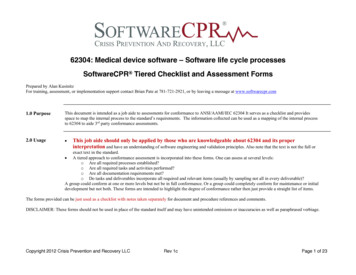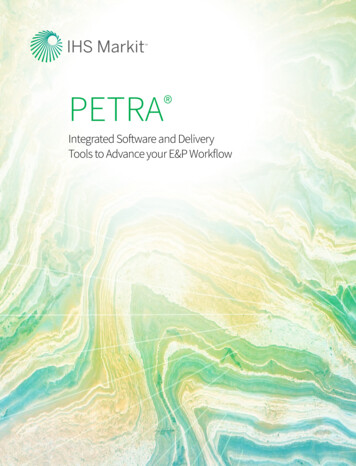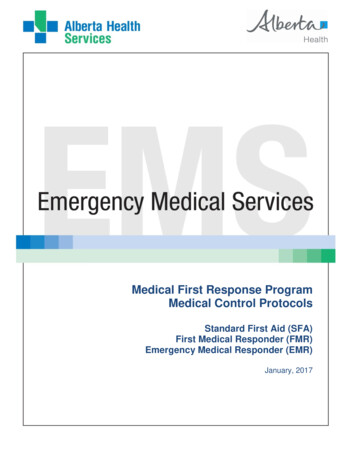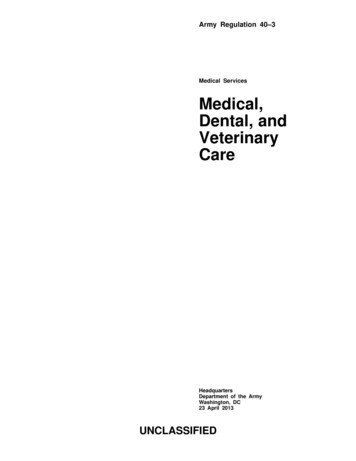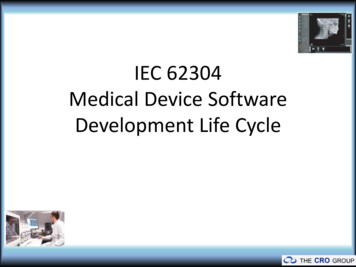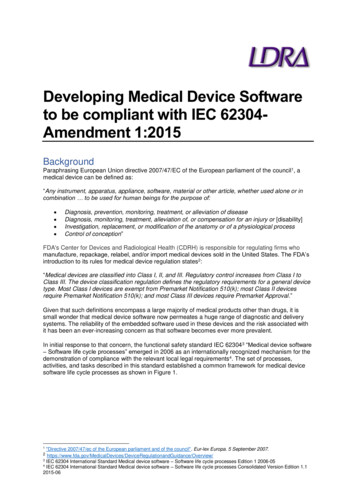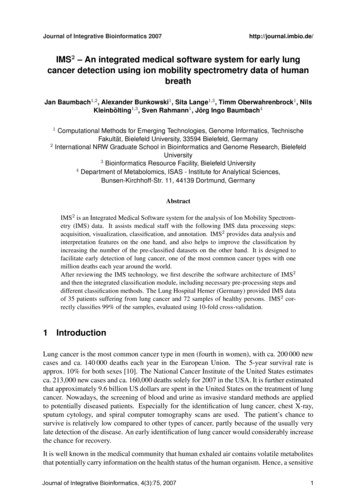
Transcription
Journal of Integrative Bioinformatics 2007http://journal.imbio.de/IMS2 – An integrated medical software system for early lungcancer detection using ion mobility spectrometry data of humanbreathJan Baumbach1,2 , Alexander Bunkowski1 , Sita Lange1,3 , Timm Oberwahrenbrock1 , NilsKleinbölting1,3 , Sven Rahmann1 , Jörg Ingo Baumbach412Computational Methods for Emerging Technologies, Genome Informatics, TechnischeFakultät, Bielefeld University, 33594 Bielefeld, GermanyInternational NRW Graduate School in Bioinformatics and Genome Research, BielefeldUniversity3 Bioinformatics Resource Facility, Bielefeld University4 Department of Metabolomics, ISAS - Institute for Analytical Sciences,Bunsen-Kirchhoff-Str. 11, 44139 Dortmund, GermanyAbstractIMS2 is an Integrated Medical Software system for the analysis of Ion Mobility Spectrometry (IMS) data. It assists medical staff with the following IMS data processing steps:acquisition, visualization, classification, and annotation. IMS2 provides data analysis andinterpretation features on the one hand, and also helps to improve the classification byincreasing the number of the pre-classified datasets on the other hand. It is designed tofacilitate early detection of lung cancer, one of the most common cancer types with onemillion deaths each year around the world.After reviewing the IMS technology, we first describe the software architecture of IMS2and then the integrated classification module, including necessary pre-processing steps anddifferent classification methods. The Lung Hospital Hemer (Germany) provided IMS dataof 35 patients suffering from lung cancer and 72 samples of healthy persons. IMS2 correctly classifies 99% of the samples, evaluated using 10-fold cross-validation.1 IntroductionLung cancer is the most common cancer type in men (fourth in women), with ca. 200 000 newcases and ca. 140 000 deaths each year in the European Union. The 5-year survival rate isapprox. 10% for both sexes [10]. The National Cancer Institute of the United States estimatesca. 213,000 new cases and ca. 160,000 deaths solely for 2007 in the USA. It is further estimatedthat approximately 9.6 billion US dollars are spent in the United States on the treatment of lungcancer. Nowadays, the screening of blood and urine as invasive standard methods are appliedto potentially diseased patients. Especially for the identification of lung cancer, chest X-ray,sputum cytology, and spiral computer tomography scans are used. The patient’s chance tosurvive is relatively low compared to other types of cancer, partly because of the usually verylate detection of the disease. An early identification of lung cancer would considerably increasethe chance for recovery.It is well known in the medical community that human exhaled air contains volatile metabolitesthat potentially carry information on the health status of the human organism. Hence, a sensitiveJournal of Integrative Bioinformatics, 4(3):75, 20071
Journal of Integrative Bioinformatics 2007http://journal.imbio.de/Figure 1: Schematic overview of the working principle of an ion mobility spectrometer.metabolic profiling of these molecules can provide essential data for the early classification oflung diseases. The application of spectrometric methods, such as mass spectrometry (MS) andion mobility spectrometry (IMS), allows the identification and quantification of molecules ingases. To detect very small concentrations of volatile metabolites, the detection limit has to bevery low (down to the pptV , pg/L ranges). Nowadays, the most common approaches utilize MStechniques [3], but these instruments are large and very expensive. If spectrometric methods areto become widely established beside other clinical tests in hospitals and point-of-care centers,the instruments have to be small, easy to use, and the price has to be moderate. For thesereasons, the application of miniaturized ion mobility spectrometers is an appropriate, fast, lowcost, and non-invasive method, which has recently been tested in several clinical studies [1, 9,8, 11].IMS Technology. The working principle of IMS is described in detail in [2]. Thus, we justgive a brief summary here.IMS is based on an appropriate ionization of gaseous analytes and a subsequent separationof the emerging positive and negative ions at ambient air temperature and pressure. Figure 1illustrates the main working principle. Ion swarms formed within the ionization region enterthe drift tube for very short shutter opening times (a few microseconds) and are separatedin an electrical field. A drift gas flows towards the ions. The drift velocity v of the ions isrelated to the electrical field strength E and the mobility k by v kE. Hence, the drifttime t, which is measured at a fixed drift length l is inverse proportional to the mobility k.The mobility depends on the collision rate of the swarm ions with the drift gas molecules, thetemperature, the ion structure, and the collision integral. The collision integral is related to theions’ size, structure, and polarisibilities. The measurement of t is performed by means of aFaraday plate, whose charge variation over time is called the ion mobility spectrum. In contrastto mass spectrometry, the drift tube has ambient pressure. Hence, beside the ions masses, alsothe collisions with neutral molecules influence the drift time. Compared to MS, IMS cannotJournal of Integrative Bioinformatics, 4(3):75, 20072
Journal of Integrative Bioinformatics 2007http://journal.imbio.de/be used for the identification of unknown molecules, but the method is much more sensitive(ng to pg, ppmV to pptV ), especially when using humid air (as in human breath) and when thesample is handled directly without any pre-enrichment. Both MS and IMS instruments are oftencoupled with gas chromatographic (GC) columns for fast pre-separation: GC/MS or MCC/IMS(MCC multi capillary column).Many other spectroscopic methods are cost intensive, time consuming, error prone, and needwell qualified staff. In contrast, recently the development of IMS technology has provideda sensitive screening in spite of comparatively low costs. IMS works with ambient pressure,ambient air, and within milliseconds (ca. 50 ms). A miniaturized IMS instrument is availablefor less than 30,000 US dollars, which is inexpensive in comparison to similar technologies.Our contributions. We contribute an Integrated Medical Software system for the analysisof IMS data (IMS2 ). IMS2 is developed to assist the medical practitioner with the followingdata processing steps:1. Acquisition,2. Visualization,3. Annotation,4. Classification,5. Automatic improvement of classification results.The last point refers to the aim of an automatic improvement of pre-classified samples, resultingin a better classification over time.We present the software architecture along with the used libraries and data processing pipelines.Afterwards, we introduce and discuss the integrated classification module and evaluate thesystem on a dataset provided by the Lung Hospital Hemer (Germany). A discussion concludesthe paper.2 Methods2.1 Software architectureThe IMS2 software has two main goals: The visualization and enhancement of the measurement An automatic improvement of the classificationThe first is to present a clear and interpretable view on the measurement taken, which is necessary to control the quality and to ensure that no problems occurred during the data generation.Journal of Integrative Bioinformatics, 4(3):75, 20073
Journal of Integrative Bioinformatics 2007http://journal.imbio.de/Figure 2: Schematic overview of the IMS2 software architecture and the data flow.This is achieved by applying normalization, histogram spreading, and filtering on the visualized image. After this process, there are possibilities to add previous knowledge based on theexperience of the medical personnel. This could be a general comment or an annotation of aparticular region of interest. This information could later help to determine why a measurement was wrongly classified. After the visualizing and commenting step, the dataset is sent toa central server which processes and classifies it (see Figure 2).Multiple clients can upload their data and classification requests at any time. The data is firstsent to the FTP server, after which the client calls a PHP script on the Apache server. Thisnotifies the data management module that new data is available. Thereupon the client data istransferred to the central server and stored as being unverified. The connection between FTPand the Apache server is fastest when running on the same hardware.The classification of the data is done by the data analysis module. For this purpose, a previouslybuilt classifier, which can be generated by the classification development module, is used. Theclassification development module provides methods for a competent user to train and evaluateclassifiers using the verified data.When the classification is complete, the client can access the classification results, which remain on the central server. As soon as new information about a measurement, or more preciselyabout the associated patient is available, the doctor is asked to comment and verify the classification result. This verified data is added to the training set, which can be used to generate aJournal of Integrative Bioinformatics, 4(3):75, 20074
Journal of Integrative Bioinformatics 2007http://journal.imbio.de/new and perhaps improved classifier. This leads to the second main goal of IMS2 , an automaticenhancement of the classification by extending the size of pre-classified sample.All data transfer is done encrypted and no patient information is sent over the internet. A uniqueID is generated, which can not be traced back to the patient’s identity, because the IMS2 systemis physically unconnected to the hospital’s patient administration network.We use PHP version 4.3.2, Apache 2.0.49, Java 1.6.0, and WEKA 3.2.2 Classification of MCC/IMS dataMCC/IMS data can be seen as an image where the peak intensities correspond to differentcolor values. Hence, methods successfully applied to image processing tasks can also be usedfor the classification of this data with respect to some specialities. Therefore we apply severalpre-processing steps to the data, followed by feature selection and classification. Since there isno need to reinvent the wheel, we use methods available in WEKA [12], a public data mininglibrary in Java for feature selection and classification.2.2.1 Pre-processingFirst we use a standard two-dimensional Gaussian filter implemented in WEKA to reduce theeffect of background noise. We choose a standard deviation of σ 1.5 and a kernel size of 5.Secondly, we detect the position of the RIP (Rest Ion Peak), which exists in every MCC/IMSimage as a continuous band from top to bottom. To this end, we use the fact that the RIPintensities exceed every other peak. For each fixed y-coordinate, we calculate from right toleft the slope between each pair of consecutive points. If the slope exceeds an empiricallydetermined value, the right point is assigned to the set of points that define the border betweenthe RIP and the right (important) part of the image. The mean value of all x-coordinates inthis set is used as a cutoff to exclude the left part of the image, which contains only irrelevantinformation for the classification. Finally, we linearly normalize all remaining values to theinterval [0, 1].2.2.2 Feature selectionWe compress the data by laying a grid over the relevant part of the image and calculate theaverage intensity value within one grid element. For each classification process, we iterateover the grid size to determine which one is optimal. In this case, each grid element with itsrespective intensity value is treated as one feature. By means of these attributes we attempt toclassify the given data. Since using the entire feature set results in very large problems, weselect significant features using the built-in methods in WEKA and compare both approachesfor different classifiers. For a successful feature selection, we need to combine an attributeevaluator with a search method. Most methods for attribute selection search for the subset thatmakes the best predictions as to which class the instance belongs to. We choose two methodsfor this purpose which empirically achieve satisfying results on our data. Further informationon the process of feature selection and the methods we use here can be found in [12, pages 288and 420].Journal of Integrative Bioinformatics, 4(3):75, 20075
Journal of Integrative Bioinformatics 2007http://journal.imbio.de/Best-First Search Method. The best-first method performs a greedy hill climbing with backtracking. We use the class ‘weka.attributeSelection.BestFirst‘ with the parameters ‘-D 1 -N 5‘.Parameter ‘D‘ indicates the direction in which is searched, for our case we search in the forwarddirection and start with the empty set. It is also possible to scan backwards from the full set,or start at an intermediate point and look in both directions. Parameter ‘N‘ denotes how manyconsecutive non-improving nodes must be encountered before the system backtracks.CFS Subset Evaluator. This evaluator individually assesses the predictive ability of each attribute and also evaluates the degree of redundancy between them. It assigns a high significanceto attributes with a high correlation with the class and with a low intercorrelation. We use theWEKA class ‘weka.attributeSelection.CfsSubsetEval‘.2.2.3 ClassificationWe compare the classification performance of the Naive Bayes (NB) classifier, MultiLayerPerceptrons (MLPs), and the Support Vector Machine (SVM). All of them have been previouslyused for data mining with GC/MS data. Hence, they may be applicable to MCC/IMS data aswell. In the following, we very briefly describe the WEKA methods we use, along with thechosen parameters.Naive Bayes classifier. The NB classifier is a simple probabilistic method based on Bayes’theorem. It assumes independent variables, which usually does not reflect reality. However,it requires just a small amount of data to estimate the necessary means and variances of thevariables; only the variances of the variables for each class need to be determined and not theentire covariance matrix [7].We use the class ‘weka.classifiers.bayes.NaiveBayes‘. Further information on the implementation of the NB classifier in WEKA can be found in [12, p.403].Multi Layer Perceptron. A MLP is an interconnected group of artificial neurons (neuralnetwork) consisting of multiple layers of interconnected computational units. Each neuronin one layer has directed connections to the neurons of the subsequent layer with adjustibleweights. The sum of input weights of a neuron is usually transformed by a sigmoid activationfunction and then passed on to the next layer. Using the training data, the algorithm iterativelyreadjusts the weights of the connections between the neurons (using back-propagation) in orderto minimize the prediction error. The network usually converges to some state where the erroris small; thus the networks learns a target function.We use the class n‘ with the default options ‘-L0.3 -M 0.2 -N 500 -V 0 -S 0 -E 20 -H a‘. Further information on the implementation of MLPsin WEKA can be found in [12, p.223].Support Vector Machine. We use the SMO feature of WEKA: an implementation of thesequential minimal optimization algorithm for training a support vector classifier [6, 4]. Thebasic idea is to find a function that approximates the training data by minimizing the predictionerror. The main difference compared to linear regression methods is that all deviations up to auser-defined threshold are discarded, so that the threshold defines a tube around the function.The risk of overfitting is reduced by trying to maximize the flatness of the regression functionsimultaneously.Journal of Integrative Bioinformatics, 4(3):75, 20076
Journal of Integrative Bioinformatics 2007http://journal.imbio.de/We use the class ‘weka.classifiers.functions.SMO‘ with the default options ‘-C 1.0 -L 0.0010-P 1.0E-12 -N 0 -V -1 -W 1 -K el -C 250007-E 1.0‘. Further Information on the implementation of support vector regression in WEKA canbe found in [12, p.219].3 Evaluation Results3.1 The DatasetWe obtained data on exhaled air of lung cancer patients provided by the Lung Hospital in Hemer(Germany) that specializes in lung diseases. The data is expertly pre-classified and split intotwo groups: 35 MCC/IMS sets (called IMS-chromatograms) of patients suffering lung cancerand 72 samples of healthy patients as the control group. Furthermore, all test patients have notbeen allowed to drink, eat, or smoke within two hours before the experiments.All measurements of lung cancer patients exhaled breath and of the control group are performed with an ISAS home made 63 Ni β-ionization source IMS. Table 1 summarizes the mainparameters of the IMS used in this study.One IMS chromatogram of the exhaled breath of a lung cancer patient is exemplarily shown inFigure 3 and visualized using IMS2 . The colors refer to different peak heights. To give a clearand comparable view on the measurement, the medical practitioner can use image processingmethods, such as normalization to values between 0 and 1, and inverting in the case of reversemeasurements. To visualize and define regions of special interest, the user can additionally calculate a histogram using user-defined minimal and maximal values for spreading. These valuescan also be determined automatically but for a visual comparison of different measurements itcould be of advantage to use fixed values. Moreover, it is possible to tag regions of interestmanually and to use a peak detection algorithm as well as a Gaussian filter to decrease background noise. The ’Received Results’ tab panel shows the results gathered from the central(classification) server.ParameterIonization sourceDrift region lengthElectrical field strengthDrift voltageShutter opening timeDrift gasDrift gas flowSample gas flowTemperaturePressure63ValueNi β-radiation source, 510 MBq12 cm330 V/cm4 kV300 µssynthetic air100 mL/min150 ml/minca. 25 C (ambient)100 kPa (ambient)Table 1: Main parameters of 63 Ni Ion mobility spectrometer.Journal of Integrative Bioinformatics, 4(3):75, 20077
Journal of Integrative Bioinformatics 2007http://journal.imbio.de/Figure 3: Screenshot of the IMS2 client software with a sample lung cancer MCC/IMS result filevisualized. The continuous band on the left side of the visualization is the so called RIP (Rest IonPeak), which is present in every MCC/IMS image.3.2 Classification ResultsThe classification performance of the classifiers is evaluated by means of 10-fold cross-validation[5], as implemented in WEKA. We report the percentage of the correctly classified MCC/IMSspectra against the size of the grids used for data reduction and filtering. We test all classifierswith and without prior feature selection (FS) for grid sizes between 3 and 150 pixels (px). Dueto the amount of features in the MCC/IMS spectra, we could not perform training on MLPswithout prior data reduction using FS for grid sizes 25 px.Figure 4 shows the classification performances for grid sizes between 3 and 40 px in incrementsof one and between 40 and 60 px in increments of ten. For grid sizes between 60 and 150 pxsignificantly worse results are achieved. Table 2 shows the best classifiers. Both MLPs andSVM provide 99.07% accuracy with very low error rates for both classes. Interestingly, theclassification results do not depend too much on the chosen grid size but more on the usedmethod. Hence, we suggest to use MLPs or SVM for the classification of lung cancer fromMCC/IMS data using a grid size of approximately 23 px.Journal of Integrative Bioinformatics, 4(3):75, 20078
Journal of Integrative Bioinformatics SyesyesyesnononononoyesnoyesnoGrid si
IMS works with ambient pressure, ambient air, and within milliseconds (ca. 50 ms). A miniaturized IMS instrument is available for less than 30,000 US dollars, which is inexpensive in comparison to similar technologies. Our contributions. We contribute an Integrated Medical Software sys

